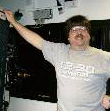|
|
This topic comprises 2 pages: 1 2
|
|
Author
|
Topic: Film-Tech Digital?
|
Mitchell Dvoskin
Phenomenal Film Handler

Posts: 1869
From: West Milford, NJ, USA
Registered: Jan 2001
|
 posted 08-05-2002 07:30 AM
posted 08-05-2002 07:30 AM




1) My eyes see things analog. Therefore, I wish to see films they way they are supposed to be seen, analog.2) There is no such thing as digital projection. There is digital media storage, there is digital transmission (moving the information from the storage device to the projector), but in order to get something visable on the screen, it eventually needs to be converted to analog. 3) When digital audio came out in the early 1980's, it offered superior storage capabilities than the analog devices it replaced, so that when it was finally converted to analog for your speakers, it sounded better. Digital video does not offer this advantage, being still inferior to it's analog predecessor. 4) Does Film-Tech Digital mean that we now have to refer to film grain as film pixals? /Mitchell
| IP: Logged
|
|
|
|
Mitchell Dvoskin
Phenomenal Film Handler

Posts: 1869
From: West Milford, NJ, USA
Registered: Jan 2001
|
 posted 08-05-2002 09:07 AM
posted 08-05-2002 09:07 AM




Yes Steve, you are indeed correct. My point was not that there are no digital projectors, but there is no digital projection. What I was trying to say is that the information has to be coverted to analog (which is what the DLP array is doing) for us to view it. We see the resultant analog light output passed though the DLP array. Converting to analog at the last step before the lens is definately the best place to do it, but IMO, at present time not better than keeping the whole process analog (film projection).Technically, all television is "digital", in that a CRT phosphor is either on (energized) or off (dark). The fact that the source for a conventional TV is not binary, or the fact that a CRT phosphor turns off at a hard preset number of milliseconds from the time it is entergized, does not alter the fact that the set has to "digitize" (in a primitive way) the signal so that the scanning beam knows which pixals to energize. We see the resultant analog light output from the phosphors. /Mitchell 
| IP: Logged
|
|
|
|
|
|
|
|
|
|
|
|
|
|
|
|
|
|
|
|
|
|
|
|
|
|
|
|
All times are Central (GMT -6:00)
|
This topic comprises 2 pages: 1 2
|
Powered by Infopop Corporation
UBB.classicTM
6.3.1.2
The Film-Tech Forums are designed for various members related to the cinema industry to express their opinions, viewpoints and testimonials on various products, services and events based upon speculation, personal knowledge and factual information through use, therefore all views represented here allow no liability upon the publishers of this web site and the owners of said views assume no liability for any ill will resulting from these postings. The posts made here are for educational as well as entertainment purposes and as such anyone viewing this portion of the website must accept these views as statements of the author of that opinion
and agrees to release the authors from any and all liability.
|

 Home
Home
 Products
Products
 Store
Store
 Forum
Forum
 Warehouse
Warehouse
 Contact Us
Contact Us




 Printer-friendly view of this topic
Printer-friendly view of this topic




















